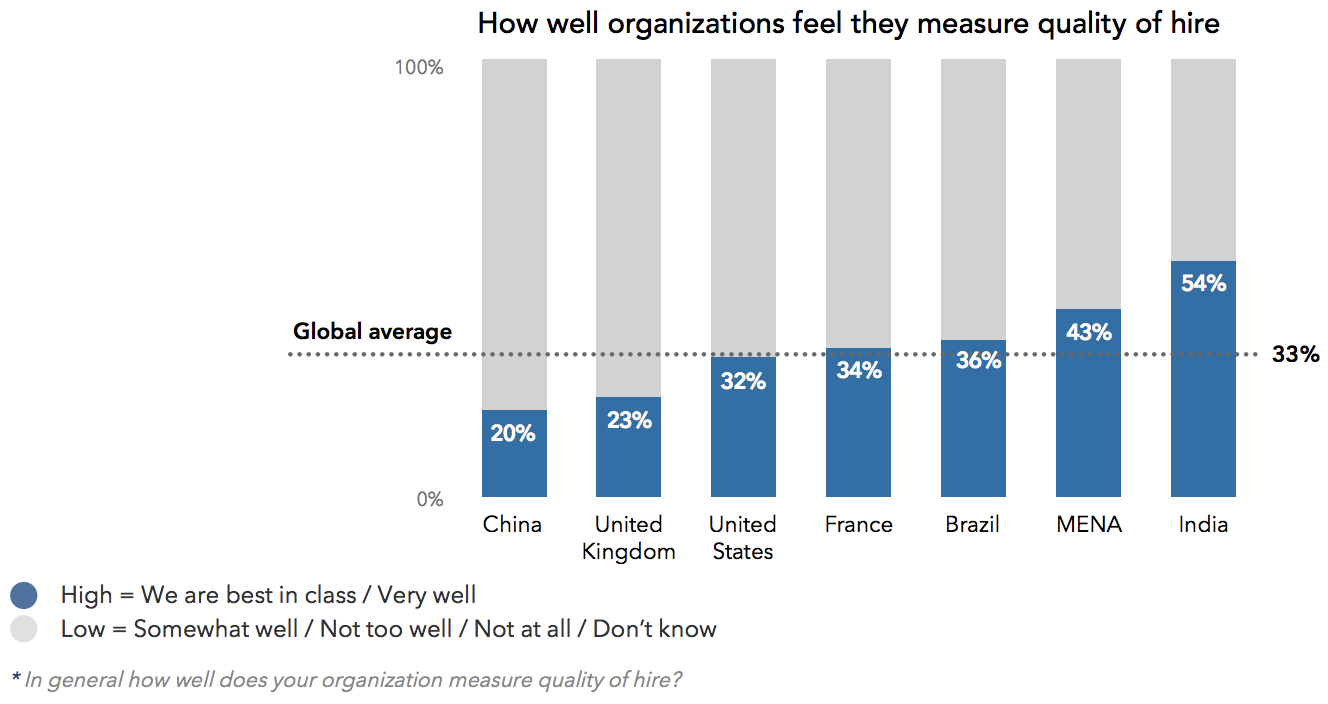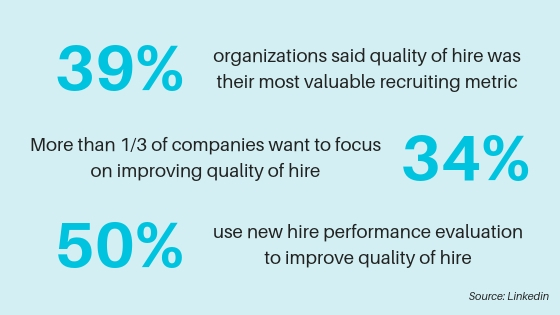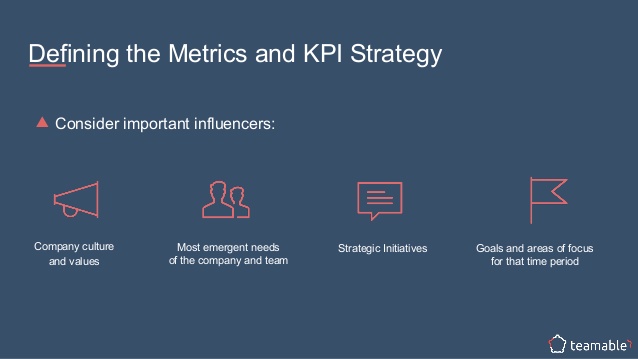As it turns out, quality is quantifiable. Many companies are turning to data to improve the quality of their hiring processes and reduce employee turnover, which is an expensive problem for many employers.
Recruiters understand that in order to be successful in the talent acquisition biz, it’s necessary to track certain metrics to measure the effectiveness of their recruitment efforts. And with so many industries today being driven by technology and data, it’s no surprise that recruiters recognize the importance of leveraging recruiting KPIs to gain valuable insights.
A LinkedIn report on the most frequently used recruiting metrics highlighted that:
- 57% of recruiters track the source of hire,
- 50% measure time to hire,
- and 36% of recruiters measure the quality of hire.
It’s not surprising that quality of hire made the list. It’s a very important metric to consider. In fact, 39% of talent leaders agree that quality of hire is the most valuable metric to evaluate performance and rank it as their top priority.
However, despite its obvious significance, quality of hire is also one of the most difficult metrics for talent acquisition teams to measure. Many shy away simply because they don’t know where to start measuring it. Only 33% of companies feel like they’re using strong tactics to do so. Even less so, only 5% of companies believe their tactics are best in class.
So let’s dive into the topic and see how you can measure quality of hire.
What’s in?
What is quality of hire?
First things first, it’s important that you understand the metric that you’re measuring. By definition, quality of hire measures the value that new hires bring to an organization.
In other words, this recruiting metric is used to evaluate how much a new hire contributes to the organization’s long-term success, based on their performance and tenure at the company.
In addition to measuring how successful a new hire becomes, quality of hire can also be used to measure the success of the company’s recruiting efforts as a whole.

Most organizations worldwide don’t feel they measure quality of hire well.
Why should you measure quality of hire?
If you’re wondering why quality of hire is important, consider this: You can’t improve what you don’t measure. Knowing your quality of hire metric means that you know where your weak points are—meaning you can adjust your strategies to reflect accordingly.
You can also connect quality of hire with other metrics to make data-driven adjustments. For example, a recruiter may notice that based on metrics, hires of lower quality are all coming from a specific source of hire, which can then inform your future recruiting strategies.
Measuring quality of hire is also useful for evaluating the performance of the talent acquisition team at the organization. How are new hires stacking up? Are the company’s recruiters placing compatible candidates?
To ensure the right candidates are placed in the right roles, it’s important that companies measure, track, and analyze quality of hire over time. By doing so, they can improve hiring processes and make better quality hires for the organization over time.
Like what you see?
Don’t miss out. Subscribe to our quarterly digest to get the latest TA and TM resources delivered right to your inbox.
Quality of hire indicators
Despite the obvious importance of understanding quality of hire, there is actually no standardized way to calculate it. There isn’t a one-size-fits-all approach to measuring quality.
Because quality of hire entails many unique variables, companies measure it in a variety of ways, using a combination of different indicators to calculate quality. Let’s take a look at the most commonly used indicators.
Job performance
According to LinkedIn, 50% of companies consider performance reviews (or just performance in general) when measuring quality of hire. While performance reviews can certainly be subjective, it makes sense to at least consider job performance while trying to measure a new hire’s quality.

Companies use various indicators in measuring quality of hire, performance appraisal score being the most popular.
Retention
This is often used as an indicator to measure the quality of hire. Simply put, the longer an employee works for an organization, the more value they contribute to the business.
By tracking the turnover rates of new hires, as well as top performers in the organization, you can leverage retention metrics to calculate a quality of hire score. Retention is harder to measure than some of the other metrics, as it’s impacted by many factors outside of the quality of hire.
Ramp-up time
Some organizations use ramp-up time as one of the variables for measuring quality of hire. This is essentially the amount of time that a new hire takes to reach full productivity in their role at the company.
Productivity
Also used to help quantify quality of hire, this is measured as the percentage of new hires that achieve full productivity in the company’s desired time frame. You can measure an individual new hire’s productivity by looking at a metric like the % of goals achieved.
Employee Lifetime Value (ELV)
This newer way indicator for measuring quality of hire represents the total net value that an employee brings to your organization. A person’s Employee Lifetime Value (ELV) is gauged over their lifespan at the organization—from day one until the very last day.
Pre-hire metrics
Pre-hire quality assessments are more short-term than the other approaches, and are meant to help predict the quality of hire. This allows recruiting leaders to be more proactive, as they can likely predict the quality of a new hire early on. These metrics can include scores on assessment and aptitude tests, time to hire, new hire attrition, referral rates by recruiter, and more.
For example, in retail volume hiring, there are certain skills and characteristics that are common among top performers, and recruiters can use pre-employment assessments to measure these skills. By identifying candidates who possess them, and who fit the company culture, they can hire better applicants who are less likely to attrit.
Check out our free whitepaper on recruitment metrics for more.
How to measure quality of hire?
There are several formulas that you can use to actually calculate a quality of hire score, but it essentially comes down to producing the average of a number of indicators.
| Quality of Hire (%) = Indicator % + Indicator % / Number of Indicators |
This formula requires you to quantify each indicator, ideally scored out of 100, in order to do your calculations. This will be especially helpful when you’re calculating an average quality score for your organization’s new hires overall, rather than by individual.
Here are a few examples of the different indicators that could be combined to calculate the quality of hire metric.
Example 1
| Quality of Hire (%) = (Job Performance + Ramp-up Time + Engagement + Cultural Fit) / 4 |
Example 2
| Quality of Hire (%) = (Job Performance + Engagement + Cultural Fit) / 3 |
Example 3
| Quality of Hire (%) = (Post-Hire Performance + Candidate Satisfaction + Retention) / 3 |
While it’s certainly useful to measure quality of hire per new employee, you can also calculate overall quality of hire by averaging the scores of all the new employees to get a better general idea about your hiring decisions. How effective is your company’s talent acquisition strategy overall?
To calculate the overall success of your hiring process, you can use this formula:
| Overall Quality of Hire (%) = [Avg. Quality of Hire score + (100 – Turnover Rate)] / 2 |
Alternatively, you also calculate your company’s overall quality of hiring score by creating a formula that is used companywide. For example:
| Overall Quality of Hire (%) = (PR + HP + HR) / 3 |
- PR = Average job performance rating of all new company hires
- HP = % of new hires with acceptable ramp-up time to reach full productivity
- HR = % of new hires that are retained after one year of employment
While you will certainly want to refine these formulas to reflect your company’s strategic business goals, these formulas should help point you in the right direction to get started. For example, If you’re like many organizations and you struggle with high turnover, you may want to include retention/turnover rate in your formula to tailor it to your organization’s unique needs.
Stop guessing,
Start data-driven hiring.
Learn how you implement a modern candidate selection process, that is: streamlined, experience-driven and backed by data.

How to collect data?
Of course, measuring quality of hire begins and ends with data. That’s why it goes without saying that in order to effectively measure quality of hire at your organization, it’s vital that you collect employee data in various forms. But where exactly does that employee information come from?
This is the part of the process where feedback becomes your very best friend.
Hiring manager satisfaction survey
Many companies use hiring manager satisfaction ratings to demonstrate how impressed (or unimpressed) hiring managers are with their new hires and the process as a whole. Are the hiring managers at your company impressed with the quality of the talent that recruiters are bringing in? You can use the survey results to collect data for quality of hire metrics, as well as to inform and improve your own processes.

Quality of hire is becoming a priority in many organizations globally.
Employee engagement survey
Why not ask your employees directly? When new hires join the team, you can survey them to gain insight into how happy a new hire is in their role. Employee engagement surveys are a great way to collect valuable information about the organization’s quality of hire. Despite being somewhat subjective, they can still be chock-full of helpful insights about the employee experience at your company.
Feedback on the hiring process
By soliciting feedback from both hired and rejected candidates, you can gain invaluable insight into the effectiveness of your company’s hiring process and make improvements accordingly. You can start by sending out a short survey to all job applicants and inviting them to share feedback on their experience during the hiring process.
For example, when using the Harver assessment flows, candidates are automatically asked for feedback at the end of the application process.

New hire performance metrics
When applicable, it can be helpful to measure a new hire’s performance metrics to measure the quality of hire. For example, this could include the percentage of sales quotas met, number of products sold, etc.
What are the challenges of using quality of hire as a metric?
One of the biggest gripes that recruitment teams have about using quality of hire as a metric is how subjective the data can be. In fact, quality, in general, is a difficult thing to measure. It’s really difficult to place a numeric value on things like employee engagement and cultural fit.
Because there’s no universal formula for calculating the quality of hire, many talent acquisition teams struggle to figure it out. However, you can overcome this by standardizing your company’s approach to measuring it. Essentially, standardizing your formula will ensure you’re always comparing apples to apples when reviewing these types of recruiting metrics.

When you’re defining how to measure quality of hire, consider what matters to your company and its goals.
To start calculating quality of hire, it’s necessary to collect a variety of different metrics over several months or even years. This can also be a major deterrent when it comes to tracking quality of hire, as some may find themselves overwhelmed by the amount of information and length of time that’s required to calculate a quality of hire score. However, after the initial setup, measuring quality of hire will be a major advantage of your organization.
At the end of the day, you can only improve on what you know—and that’s exactly why you should know and keep track of quality of hire at your organization. By measuring quality of hire, you gain insights into the efficiency of your team’s work and the effectiveness of your recruiting efforts as an organization.
You can leverage these insights to identify areas for improvement, highlight what’s currently working well, and ultimately make sure you’re putting the right people in the right roles to best meet the needs of the business.


